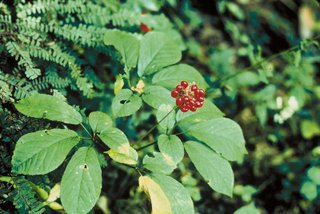Ginsengs Minimum Viable Population - Part I

Image: Ginseng in a market in Korea, by Richard Fabi
The English word “ginseng” is derived from the Chinese term rénshēn (simplified: 人参; traditional: 人參), literally "man root" (referring to the root's characteristic forked shape, resembling the legs of a man). It was originally the common name for several plants valued for their medicinal properties; although ginseng is now most often associated with the genus Panax, some researchers believe that the original ginseng used in ancient China may have been a different plant. Although ginseng is often seen as an East Asian medicine, American ginseng has been used by Native Americans for centuries.
American ginseng is a slow-growing, long-lived (50 plus years) herbaceous perennial of the Araliaceae family. The species is endemic to Eastern North America, occurring in southern Canada (Ontario and Quebec) west to South Dakota and Oklahoma and south to Georgia. Ginseng is a species of stable habitats, such as the understory of mid-successional to late-successional deciduous forests. Plants emerge after the leaf canopy has partially or fully developed.
Below ground, ginseng forms a thick taproot, a special underground stem known as a vertical rhizome sits on top of the main root and sends up the above-ground stem each year. The rhizome is characterized by large scars that form as a result of the annual abscission or accidental loss of the single subterminal aerial stem. These annual scars are well-marked on the rhizome and can be counted to determine the age of the plant. Growth rate varies among individuals, so plants with the same number of leaves and leaflets may be close but not identical in age.

Image Right: Panax quinquefolius - US FWS photo
Ginseng leaves are whorled, with three to five leaflets. An individual whorled leaf with a petiole is referred to as a “prong,” and is commonly used to indicate the size-class or age of individual ginseng plant.
Typically, ginseng has been divided into four size-classes based on the number of leaves or prongs. Generally, one-prong plants (with 3-5 leaflets) are 2 years of age, two-prong plants (with 10 leaflets) ranged from 3 to 6 years of age, three-prong plants (with 15 leaflets) ranged from 7 to 9 years of age, and four-prong plants (with 20 leaflets) ranged from 10 to 11 years of age. Four- and five-prong plants represent the oldest individuals of a population. Wild ginseng plants do not reproduce until they are at least 4 years of age.
Ginseng has perfect flowers (bisexual flowers): an individual flower has both stamens (male) and carpel’s (female). Although ginseng does have a high natural rate of self-fertilization, cross-pollination between plants has been reported. However, ginseng is not capable of producing seed without any form of fertilization.
The fruits of the ginseng turn red at maturity and typically have two-seeds in each berry-like fruit, although it is very infrequent, ginseng fruit can yield three and four seeds. A typical flowering 4-year-old wild ginseng plant may produce 30-40 fruits on each inflorescence.
The primary cause of decline for ginseng is that of exploitation by harvesters in response to consumer demand. The species is designated as “Endangered” in Canada; the export of wild-harvested ginseng roots is prohibited by law. In the United States, wild-collection of ginseng is not permitted or is discouraged in Connecticut, Delaware, Maine, Massachusetts, Michigan, and Rhode Island due to declines in populations. Under State laws, ginseng is listed as “endangered” in Maine and as “threatened” in Michigan. Declines have been documented on National Park (NP) lands, U.S. Forest Service (USFS) lands, and throughout many other areas within the species’ range, including in Arkansas, Georgia, Illinois, Indiana, Kentucky, Minnesota, North Carolina, Ohio, Pennsylvania, Virginia, West Virginia, and Wisconsin.
Between 1991 and 2001, 11,654 pounds of illegally harvested ginseng roots (an estimated 3,496,200 plants) were seized in the GSMNP, which encompasses 800 square miles (512,000 acres) within the core of the species’ range. In 2002, at Mammoth Cave National Park (MCNP), a poacher was apprehended with 19 pounds of green ginseng roots (an estimated 5,700 plants). The average would be 300 roots per pound at a one-to-one ratio of root to plant.
To combat the illegal harvest of ginseng in national parks, the NPS has implemented several preventive strategies, such as permanently marking ginseng roots which cause the roots to be unacceptable for sale. Ginseng poaching is not restricted to Federal and State lands; it also affects private land owners.
The purpose of designating species as a USFS Regional Forester Sensitive Species is to protect rare species and their habitats before there is a need to list species as “threatened” or “endangered” under the U.S. Endangered Species Act. Species designated as Sensitive Species are vulnerable due to low populations and other risk factors. By designating ginseng as a Sensitive Species, USFS policy mandates the completion of a conservation assessment of the species. The conservation assessment will provide a review of known information regarding the species’ distribution, habitat, ecology, and population biology. Upon completion in 2004, the USFS developed a conservation strategy for ginseng on National Forest in the Eastern Region.
Technorati Tags: [Blue Ridge Mountains] [ginseng] [China] [East Asian medicine][America] [Native Americans] [Canada] [Georgia] [Virginia] [West Virginia] [North Carolina] [Pennsylvania] [Kentucky]

1 Comments:
At Sunday, 09 April, 2006, Karen said…
Karen said…
This post brings back vividly a memory of hiking in Tennessee or North Carolina at least two decades ago. My (then) husband and I hitched to the trail with an old fellow who described the process of harvesting ginseng--starting with how to find it. The next day when my husband had left me behind, I sat down for a rest and looked uphill--ginseng everywhere. You could only see the red berries from below.
We weren't harvesting, of course, but it made me laugh to think I had found something he missed, because I took a moment to sit down.
Post a Comment
<< Home